sustainable forest management plan
for special-use and protection forests
About
This website aims to support forest owners managing special-use and protection forests to develop Sustainable Forest Management Plans (SFMPs) in accordance with the 2017 Forestry Law and Circular 28/2018/TT-BNNPTNT. The below content summarizes technical guidance and international best practices on Sustainable Forest Management Planning. It reflects on implementation experiences from four pilot sites: Cat Tien National Park, Bidoup Nui Ba National Park, Than Sa Phuong Hoang Nature Reserve and Tram Tau Protection Forest Management Boards.
As a result, this Question & Answer website guides forest owners and relevant experts throughout the process of SFMP development. It provides a reference and recommendations how to solve common problems in the development and approval process of the SFMP. The development of a high quality and implementable management plan, eventually contributes to improved and sustainable forest management throughout the period 2021–2030. The content presented here is a product of the Programme on Conservation and Sustainable Use of Forest Biodiversity and Ecosystem Services in Viet Nam.

- Chapter 1: Introduction
- Chapter 2: Objective
- Chapter 3: Subject & Principles of application
- Chapter 4: Steps of SFMP Development
- Chapter 5: Common questions & issues in the development of sustainable forest management plans
Sustainable forest management (SFM) is an important solution for the management of forest resources, improving their economic, social, and ecological value. Implementation of sustainable forest management plans (SFMP) contributes to protecting and developing forest resources and improving the environment, ecology, economic efficiency, and the lives and cultures of local people.

Although substantial efforts have been made by the government and stakeholders, the results of SFM implementation in Viet Nam have been limited. In response, the 2017 Forestry Law stipulates that forest owners develop and implement a SFMP and assigns the Ministry of Agriculture and Rural Development (MARD) to guide implementation. MARD issued Circular No. 28/2018/TT-BNNPTNT on sustainable forest management, which stipulates that forest owners managing protection, special-use, and production forests, must develop and implement SFMPs; while forest owners that are communities, households, and individuals are encouraged to develop and implement SFMPs. SFMPs are important tools that help forest owners define and achieve forest management objectives in accordance with the requirements of sustainable forest management.

Regulations on SFMPs have been specifically issued in Circular No. 28/2018/TT-BNNPTNT. Moreover, in 2018, the Viet Nam Administration of Forestry (VNFOREST) issued a handbook and guiding documents for the implementation of sustainable forest management, which contains guidance on the development of SFMPs for special-use, protection, and production forests. However, when developing and approving SFMPs, forest owners, as well as appraisal and approval agencies, still face several issues that require clarification from authorities or experts, especially on SFMPs for special-use and protection forests. These forest categories are managed by complicated management regulations, with priority given to the implementation of environmental, ecological, and social objectives. Forest management activities should focus on forest conservation, protection, and development, and therefore mainly rely on the state budget. The liability of forest owners is high, requiring sufficient information and the legal basis to identify activities, estimated budget needs, and clear funding sources. The approval process is also scrutinized and involves several appraisal authorities.

This handbook has been developed with the aim of providing information and clarifying common problems encountered during the development of SFMPs for special-use and protection forests. Its contents are structured in a question and answer (Q&A) format based on the common problems encountered by forest owners and authorities that are not mentioned in specific regulations or guidelines.
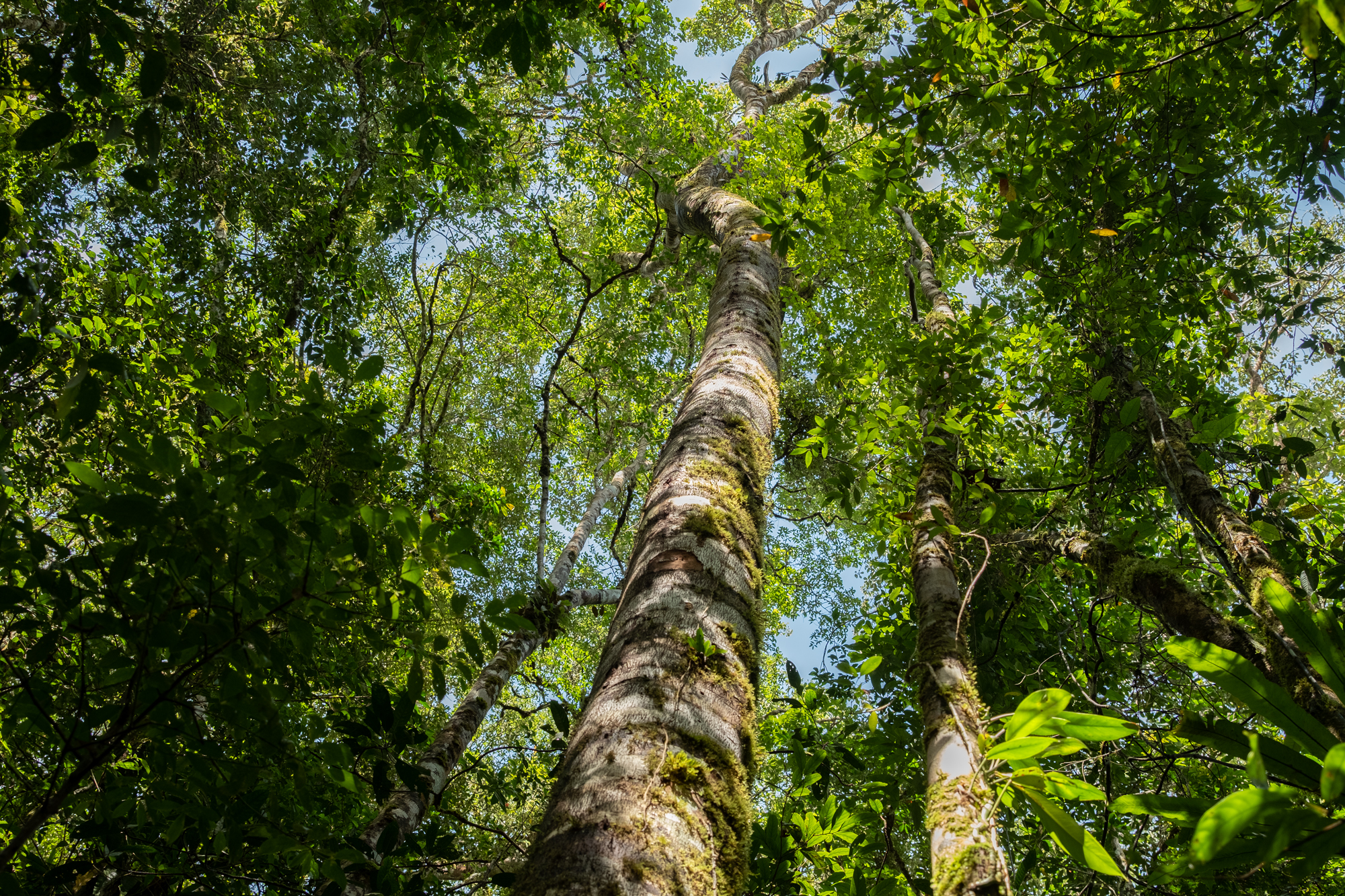
The objective of the guidelines is to help forest owners managing special-use and protection forests to develop SFMPs in accordance with the 2017 Forestry Law and Circular 28/2018/TT-BNNPTNT.
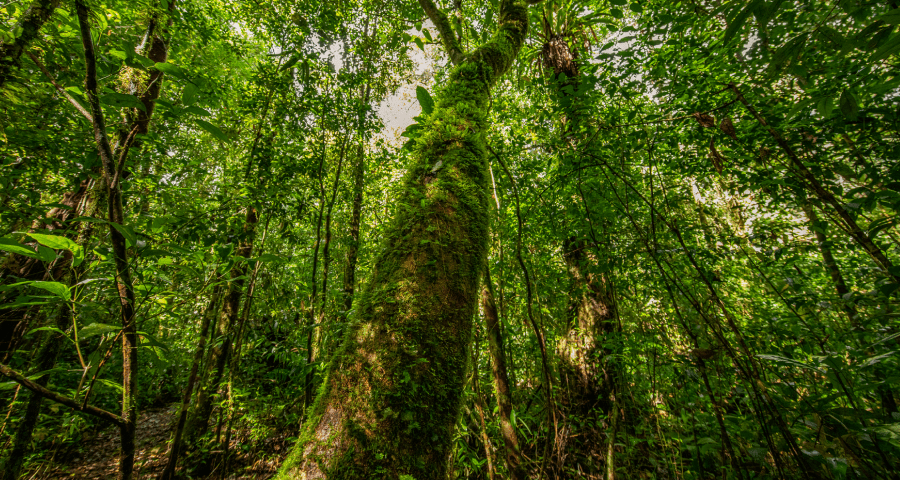
Special-use forests
To achieve the goals of protection, conservation and development of biodiversity and forest resources, environmental protection and harmonization of social benefits, especially for local communities, in National Parks, Nature Reserves, Species-Habitat Conservation Areas, Landscape Protection Areas, and scientific research organisations managing forests and forestry land for scientific research.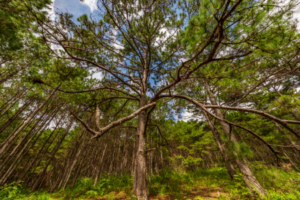
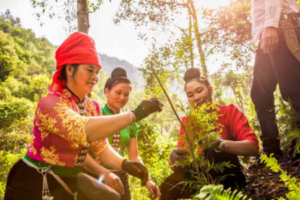
Protection forests
To achieve the goals of forest protection, restoration and development, environmental protection and harmonization of social benefits, especially for local communities, in protection forest areas.These guidelines are not a legal document, but are meant to be used as a reference source or instructions to solve common problems in the development and approval of SFMPs forest owners need to comply with relevant legal regulations to develop appropriate SFMPs.
The quality of SFMPs mainly depends on the professional knowledge and capacity of SFMP developers. These guidelines do not provide that knowledge, so developers need to access other documents on professional knowledge related to SFMP development if necessary.
These guidelines should not be applied mechanically; the answers should be applied according to actual forest conditions.

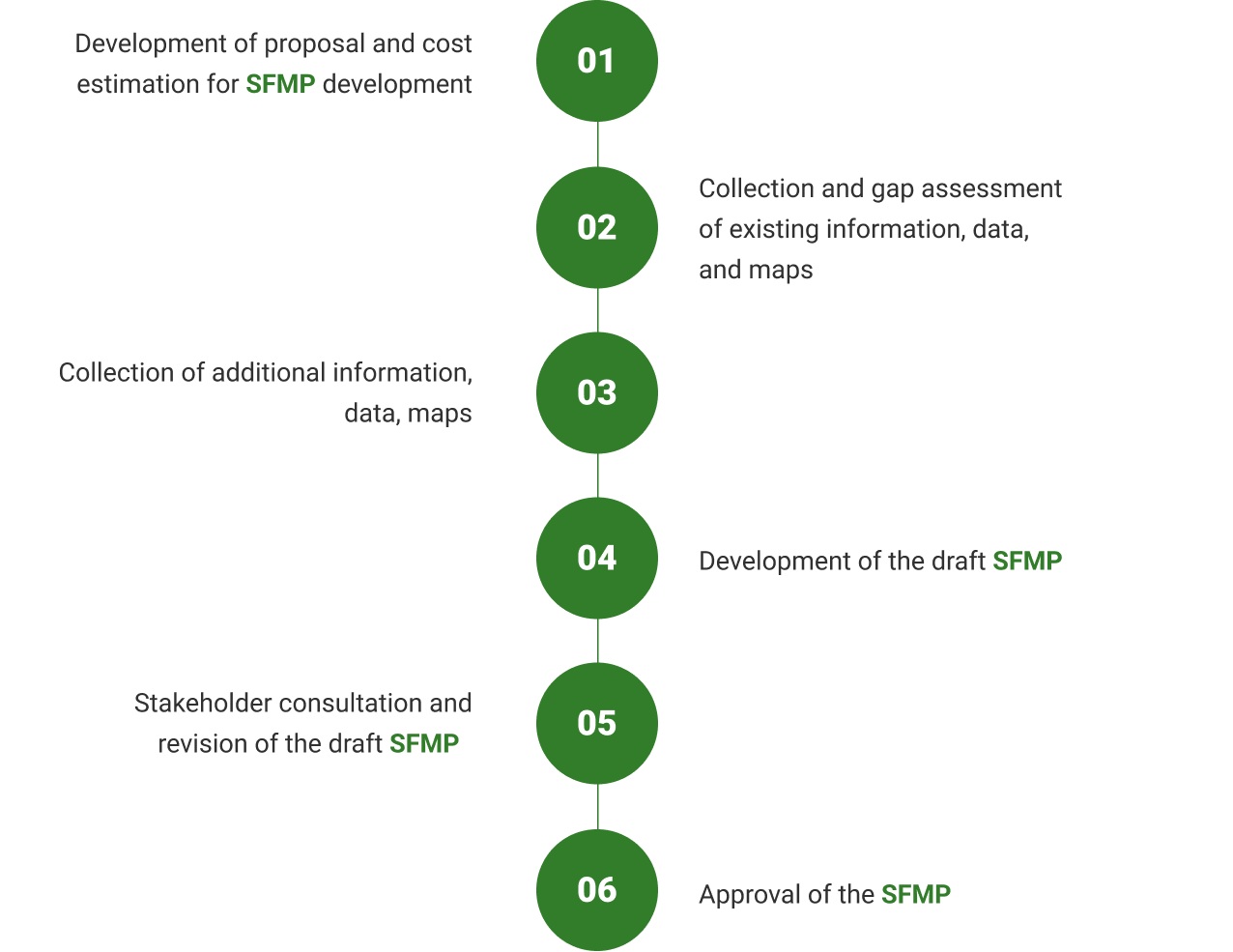

The development of the proposal and cost estimation helps forest owners clearly define the objectives, activities, methods, plans and necessary budget to develop SFMPs in accordance with their current situation. Furthermore, most owners of special-use and protection forests are state organisations, so the approval process is strict. Article 10 in Circular 28 stipulates that forest owners develop plans, proposals and cost estimates for the development of SFMPs; however, it lacks specific guidelines so many forest owners are confused about the proposal development and approval process. This wastes time and affects the quality of proposals and SFMPs. Guidance on common issues when developing proposals and cost estimates includes the following:
a) Procedures for the development and approval of proposals and cost estimations
Follow the regulations of relevant authorities (cf. Article 10, Circular 28), which may include the following steps:
1) Agreement on the development of the SFMP: owner requests the authority to agree on the development of the SFMP.
2) Development of the proposal: The forest owner can develop the proposal and cost estimation themselves or hire a consultant. If hiring consultants, the forest owner needs to develop clear terms of reference (ToR) to ensure that a consultant is selected that meets the requirements for developing a SFMP. The forest owner needs to determine the funding sources for hiring consultants.
3) Submitting the proposal for approval: The forest owner submits a draft proposal and cost estimate to the superior agency for approval. The superior agency assigns an affiliated authority to appraise the proposal and cost estimate.
4) Appraisal of relevant authorities: After receiving the draft proposal, the appraisal authority sends the draft proposal and cost estimate to other relevant authorities for comments. The appraisal agency synthesizes the appraisal comments and requests the forest owner to revise the draft proposal and cost estimate. If necessity, the appraisal authority can set up an appraisal council and hold a review meeting.
5) Revision and approval: The forest owner revises the outline and cost estimate according to the comments and sends it back to the appraisal authority. The appraisal authority reviews and submits it to the superior agency for approval.
Example: For forest owners under the Provincial People’s Committee (PPC), the agreement of the PPC is required for the development of a SFMP. The forest owner develops a ToR to recruit consultants to develop the proposal and cost estimate. The Department of Agriculture and Rural Development (DARD) is the appraisal authority. DARD collects and synthesizes appraisal comments from relevant departments and agencies such as the Department of Planning and Investment, Department of Finance, Department of Natural Resources and Environment, and requests forest owners to revise the proposal and cost estimate accordingly. The forest owner submits the revised proposal and cost estimate to DARD. DARD then reviews and submits the proposal and cost estimate to the PPC for approval.
b) Main content and cost estimates
The proposal and cost estimation should include the following information:
1) The necessity for developing the SFMP: Stating the needs for developing the SFMP on the basis of legal regulations, current status, and the objectives of forest management, particularly forest restoration, conservation and the participation of local communities in forest management.
2) Legal documents: List of the legal documents that the forest owner has used for the development of the SFMP; the documents include those from central and local levels, and legal documents related to the forest owner.
3) Objectives of SFMP development:
– Overall objective: To develop and implement a SFMP in accordance with the law and actual conditions of the forest owner.
– Specific objectives: Collect and update information, data, maps of current land use, forest resources, biodiversity, forest environment value, ecotourism; identify forestry objectives, planning for all activities; propose solutions for implementation, monitoring and evaluation, and estimating the required budget and sources for implementing the SFMP during a certain period
Note, these are goals of SFMP development, which differ from the goals of SFMP implementation.
4) Activities and methodology: Determine the activities needed to develop the SFMP (see section 2.3.1.c). Clearly describe the specific methods for the implementation of each activity. Methods should be based on regulations, guidance or with reference to practical experience related to the activity. Detail and volume of work, and place of implementation should be clearly stated as a basis for estimating costs.
5) Expected outputs: List the outputs to be achieved, such as thematic reports, figures, maps, SFMP, etc. If the forest owner hires a consultant to develop the SFMP, an additional output (terms of reference (ToR)) should be included.
6) Schedule: Clearly stating the time, progress of implementation, responsibilities of stakeholders, and deliverables to be achieved for each activity.
7) Implementation and monitoring and evaluation
– Describe the method of implementation (such as hiring consultants or self-implementation);
– Describe the method of monitoring and evaluation (M&E) of the SFMP development process. If necessary, set up a M&E team to monitor and evaluate the SFMP development process.
8) Estimation of cost and budget sources: based on the current regulations and norms to estimate the required budget and budget sources of to develop the SFMP.
c) How to determine the activities in the proposal that will be carried out when developing a SFMP?
The activities are extensive enough to generate the information, data, or maps for the development of the SFMP as required in Circular 28 (c.f Articles 5, 6 and Appendices in Circular 28). However, the actual situation of the forest owner, the goals of the SFMP, the availability of information and data as well as available budget and human resources will determine the activities to be carried out. The activities will be determined based on the following criteria:
1) Requirements of Circular 28: Ensuring the requirements of Circular 28 are met is a necessary condition for approval of the plan. Therefore, it should be determined whether the activities to be carried out have enough information, data, and maps as required by Circular 28. However, forest owners may have existing information, data and maps, so a gap assessment should be conducted to identify what activities should be carried out.
2) Objectives of SFMP development: Based on the current situation of the forest owner and the goals of the SFMP, there may be some activities that are not necessary, but there may be additional activities.
3) Available information, data, and maps: Depending on the availability and how up-to-date information, data, and maps are to determine activities. For example, if the information, data, and maps have been updated, they can be used to develop the plan without additional collection and inventory. In contrast, if information is missing or data and maps are significantly different to the current status, they need to be updated through additional surveys, inventories, etc. (See section on information, data and maps below).
d) Financial norms and regulations to estimate the cost for the development of a SFMP
Available budget and human resources of forest owners: To develop a high quality SFMP, it is necessary to have all the necessary information and data fully updated. However, this may be costly and time consuming. Therefore, if the available budget and human resources are limited, it is possible to use existing information, data, and maps from the latest inventory; however, existing information needs to be reviewed to ensure the minimum requirements for information, data, and maps are met. If the available budget and human resources are sufficient, additional surveys and inventories may be conducted to ensure sufficient data for development of the SFMP.
The activities to be carried out to develop the SFMP are diverse, including forest and biodiversity inventories, environment and social impact assessments, map development, meetings, bidding costs, etc. Currently, there are no regulations or norms specifically regulated to estimate costs for the development of a SFMP. Thus, the forest owner has to use existing regulations and norms to estimate the required budget; for example, Decision 487/QD-BNN-TCCB on forest inventory and mapping; regulations for per diems, meetings, etc.; Decree 63/2014/ND-CP guiding the Law on Bidding and other related regulations.
Information, data, and maps are important inputs for the development of SFMPs; they are mainly used to determine the scale, locations, and plans for implementing forestry activities in the SFMP. For special-use and protection forests – as most forest protection, conservation, and development activities will use state budget funds for implementation – the appraisal authorities often require legible and updated data and maps when approving SFMPs. However, due to various reasons, many data and maps have not been updated or may not match the actual situation that the forest owner is managing. These issues are constraints for forest owners in the process of approving a SFMP. However, updating and additional collection of data and maps, such as current land-use status, current forest status, and forest resources is costly and time consuming. Meanwhile, a SFMP is considered a long-term plan and can be updated and revised as needed during the implementation process. Therefore, the actual conditions, available resources, and funding of the forest owner will determine how up-to- date the data and maps need to be. For forest owners with the available budget and human resources, it is possible to carry out additional surveys to obtain sufficient data and maps for SFMP development. For forest owners with limited budgets and human resources, data and maps with clear legality in the recent period can be used. As regulated in Circular 33, the national forest inventory is implemented every 5 years, so forest owners can revise SFMPs when updated data and maps become available in the subsequent forest inventory. In addition, where data gaps have been identified, these can be pointed out in the SFMP accordingly and the collection of relevant data can be proposed as a specific measure in the SFMP.
a) Origin, legality, how recent secondary data need to be, such as socio-economic conditions and infrastructure data, national defence, and security
Inherited from the most up-to-date, clearly sourced secondary documents such as the local statistical yearbook, annual reports of local government agencies, and relevant authorities. Only use information related to the development and implementation of the SFMP. Collected information is analysed to identify advantages, disadvantages, shortcomings, and to propose what needs to be considered in the development and implementation of the SFMP. (cf. Articles 4, 5 and 6 of Circular 28)
b) Sources of land – use status data and maps, and how recent this data need to be
Use the latest approved land-use status data and maps. If they have not been updated for 5 years (according to the regulation on land-use inventory in Article 6, Circular 27/2018/TT-BTNMT) or there is a major change (for example, the conversion of land-use purpose, reallocation of land to other local entities, etc.) it is necessary to review and conduct an additional inventory according to land-use inventory guidance in Circular No. 27/2018/TT- BTNMT. (cf. Articles 4, 5 and 6 of Circular 28)
c) Sources of forest status data and maps, and how recent this data need to be
Use the latest approved forest status data and maps. In case the data and maps have not been updated for 5 years (according to the regulation of forest inventory in Circular 33/2018/TT-BNNPTNT) or there is a major change (for example, change of forest types due to natural disasters, forest fires, illegal deforestation, conversion of forest to other land-use types, etc.) an additional inventory is required following guidance on forest inventory in Circular 33/2018/TT-BNNPTNT. To minimize costs, additional inventories should be prioritized in poor and extremely poor natural forests, un-forested land and planted forests (Circular 33/2018/TT-BNNPTNT) to obtain updated data and maps for planning forest development activities; for medium forest types or higher, it is not necessary to carry out additional inventories. (cf. Articles 4, 5 and 6 of Circular 28)
d) The data and maps of current land-use status and actual forest status do not match
Data and maps of current the land-use status and the forest status often do not match. In this case, additional inventories are required to obtain actual data of the current land use and forest. Guidance on land-use inventories is given in Circular 27/2018/TT-BTNMT and for forest inventories in Circular 33/2018/TT-BNNPTNT.
e) The area recorded in the recently approved forest inventory and the actual forest area that the forest owner manages do not match
As mentioned in sections b and c above, if the recently approved data was recorded in the 5 previous years, or if there are no major changes and the forest owner has a limited budget, the recently approved data can be used for SFMP development. When data and maps are available in the next inventory, the SFMP can be revised accordingly. If there are major changes, the forest owner needs to mobilize resources to carry out additional inventories to obtain actual data and maps of land use and forest status. Guidance on land-use inventories is given in Circular 27/2018/TT-BTNMT and for forest inventories in Circular 33/2018/TT-BNNPTNT.
f) Sources of forest resources data and how recent this data need to be
Forest resources data include timber stock volume, non- timber forest products (NTFPs) and biodiversity. How recent the data needs to be is determined based on forest categories, specifically as follows:
1) Timber stock volume: Timber volume data is used to classify the richness levels of the forest and the logging plan for forest types where harvesting is permitted:
– For the additional inventory to classify forest status as mentioned in section c, a timber stock inventory should be conducted to classify poor, extremely poor, un-forested land and planted forests
– For the additional inventory to develop a harvesting plan, according to the current regulations, except production forests only timber from planted forest in protection forests and scientific research forests can be harvested; harvesting is not permitted in all remaining forest categories (Articles 52 and 55 of the Forestry Law; Articles 12 and 20 of Decree 156). Thus, a high accuracy of timber stock volume data in special-use and protection forests for use in the development of the SFMP is not necessary; timber volume data approved by regular forest inventory is sufficient. For planted protection forest, if there is no up-to- date data and it is expected that during SFMP implementation there may be a need to harvest timber from nursery trees and target trees when the forest has ensured its protection function, it is necessary to carry out additional inventories to collect fresh data on the volume of planted protection forest for the development of a harvesting plan.
2) Non-timber forest products: Current regulations do not allow the harvest of NTFPs in special-use forests, only in protection forests. Therefore, for each forest category, data collection can be carried out as follows:
– For special-use forests, it is possible to use NTFP data from the latest forest inventory results. An additional inventory is not necessary.
– For protection forests, Article 55 of the Forestry Law and Article 20 of Decree 156 stipulate that the harvesting of NTFPs must ensure sustainable development and not affect the protection function of the forest. Thus, to develop a harvesting plan for NTFPs, it is necessary to have detailed NTFP status data for every product group. Although there are available NTFP data from the forest inventory, NTFP species are diverse and the stock volume has a large degree of variation over time due to regular harvesting, use, and seasonal production. Therefore, NTFP data in the latest forest inventory may not be sufficient for planning sustainable harvesting, only to be used to determine the potential NTFP value of the forest. However, a detailed inventory of NTFP availability is also difficult to implement immediately because it is costly, time consuming, and requires expertise. Thus, NTFP data from the latest inventory can be used to identify the potential for the development of NTFPs, and a detailed plan will be carried out in the SFMP when it is approved entitled: “Investigation and planning for sustainable NTFP development and harvesting”. This activity should be addressed with the participation of communities and stakeholders in its development, harvesting, and benefit- sharing in accordance with current regulations.
3) Biodiversity (flora and fauna): Having complete biodiversity data is necessary to develop management plans and strategies for biodiversity conservation. However, obtaining complete data requires high levels of expertise, funds, and time. Therefore, the following methods can be applied to obtain appropriate biodiversity data for the development of SFMPs:
– For special-use forests, when a special- use forest management unit is established, the results of the survey and assessment of biodiversity are quite complete and updated according to regulations. Thus, an additional inventory is not necessary but data can be taken from existing secondary documents and a survey then conducted to verify the data. The survey should focus on ecosystems and groups of endangered, precious, and rare animals and plants according to regulations (especially species in Decree 06/2019/ND-CP). The survey method can be applied as follows: (1) Synthesize information from secondary documents about endangered, precious, and rare species and ecosystems; their scale and location of distribution, existence, development, and their habitats; (2) Interview local people and other stakeholders to verify available information and collect additional information if any; and (3) Conduct a transect survey to verify the available information. If any additional investigations are needed, the method used should be in line with the regulation in Circular 33/2018/TT-BNNPTNT (find attached appendix for guidance on specific investigations).
– For protection forests, normally, the data on biodiversity are not fully researched as for special-use forests. However, a comprehensive biodiversity survey requires a significant budget and significant time. Therefore, the method for evaluating biodiversity in protection forests can be applied following the three steps for special- use forests outlined above.
What additional information and data need to be investigated and assessed: Assessment of environmental and social impacts; evaluating forests of high conservation value; determination of the value of culture, history, landscape, etc.
Special-use and protection forests have the main functions of biodiversity conservation, and environmental and ecological protection, which have a significant social impact. To obtain basic information and data for identifying forestry activities, planning, and solutions to implement a SFMP, it is necessary to identify the interactions between forest management activities and the environment, ecology, and society. Therefore, surveys are required to collect additional information on various topics such as assessing the impact of forestry activities on the environment and society, identifying high conservation values, and the potential for forest environmental service activities and ecotourism. The specific issues are as follows:
a) Method of assessing the impact of forestry activities on the environment and society
The assessment of the impact of forest management on the environment, ecology, and society is essential. The detailed assessment method is published in the “Guidelines for the implementation of sustainable forest management” by the Viet Nam Administration of Forestry (VNFOREST) and in the “Summary guidance of international best practices and site observations in the context of Circular 28” by GIZ.The assessment should ensure the following factors:
– The scale of the assessment should include communities living near or in the forest (buffer zone), and stakeholders in the management area of the special-use forest adjacent to and participating in the management/protection of protection forests.
– The content of the assessment should consider all direct and indirect, positive and negative impacts on the environment, ecology, and society when implementing the SFMP.
– The assessment must ensure the participation of local people and stakeholders through consultation, discussion, the analysis of problem trees, etc.
Required in Appendix I (criteria for sustainable forest management)
b) Evaluate the high conservation value (HCV) of forests when developing the SFMP
The guidance for determining HCVs in Appendix IV of Circular 28 specifies how to identify HCVs, including biodiversity values (HCV1), landscape (HCV2), endangered precious and rare ecosystems (HCV3), water and soil protection (HCV4), community needs (HCV5) and culture and beliefs (HCV6). However, according to the legal regulations on special-use and protection forests, some of these values have been evaluated, classified, and managed in accordance with the law Thus, additional assessments can be carried out as follows:
1) Special-use forest: The biodiversity values (HCV1) and the ecosystem (HCV3) have been identified according to special-use forest functional zoning and additional investigation as in section 2.f. Most special-use forests are natural forests that are strictly managed and protected, so the protection functions of the forests (HCV4) are high. The value of community needs (HCV5) can be assessed in combination with the social impact assessment activity as indicated in section 3.a. The areas of landscape value (HCV2), culture, history, beliefs (HCV6) will be surveyed and assessed as the basis for conservation planning and development of ecotourism services as in section 3.c below. The evaluation method for HCV6 can be seen in the HCV assessment toolkit in Appendix TT 28.
2) Protection forest: As this forest category is protection forest, so the protection value (HCV4) has been determined according to the protection function of the forests, including protection of watersheds, wind breaks, moving sand, waves, sea encroachment, etc. Similar to the method described for special-use forests above, the biodiversity (HCV1) and ecosystem values (HCV3) have been determined as in section 2.f. The value of community needs (HCV5) can be assessed in combination with the social impact assessment activity as indicated in section 3.a. The areas of landscape value (HCV2), culture, history, beliefs (HCV6) will be surveyed and assessed as the basis for conservation planning and development of ecotourism services as in section 3.c below.
(c.f. Articles 5 and 6 of Circular 28)
c) Identify and evaluate cultural, historical and landscape values
The HCV assessment toolkit in Appendix 28 can be applied to evaluate the cultural, historical, (HCV6) and landscape values (HCV2) of the forests. In general, to develop the plan for the protection and conservation of historical cultural values, and for the development of landscape values such as ecotourism and recreation, information and data should be collected as follows:
– Collect general information and a list of areas of cultural, historical, and landscape value within the management area based on secondary documents and interviews with local authorities, communities, residents, and stakeholders.
– From the list and general information, survey each site to collect information about the scale of cultural, history, and landscape values. Interview or discuss with local people and stakeholders to verify and supplement information, and propose activities to manage and develop those values.
(c.f. Articles 5 and 6 of Circular 28)
How to define forestry activities; scale and plan of each activity.
Before identifying and planning the activities in the SFMP, it is important to identify forest management objectives, which include the general objective (demonstrating the strategic vision) and the specific objectives to address the strategic vision. Activities are then identified and planned to address the identified objectives.
Before identifying and planning the activities in the SFMP, it is important to identify forest management objectives, which include the general objective (demonstrating the strategic vision) and the specific objectives to address the strategic vision. Activities are then identified and planned to address the identified objectives.
The identified activities and their implementation plans should be feasible, considering the risks, constraints, and opportunities in the long term. However, since the SFMP can be revised when needed, it is not limited to the inclusion of activities where opportunities or resources for implementation are foreseen, such as the development of national and local policies, approved projects, or international funding commitments, etc. The activities that cannot be implemented during the development of a SFMP due to limited human or financial resources can be proposed for implementation after the SFMP is approved
Specific questions on planning forestry activities that are often asked when developing SFMPs are answered below:
a) By 2020, many policies on investment and support from the government will have ended. There should be specific guidance for planning forestry activities.
Article 91 of Decree 156 regulates that the current related policies will continue to be applied until the government issues new ones. Therefore, these policies still apply for the development of the plan until new policies are issued; the SFMP will be revised accordingly, if necessary.
b) Land-use planning for areas in the protected areas of special-use forests where local people lived before the establishment of the protected area.
To avoid any negative social impact, land-use planning for these areas should be based on adequate information and data collected using a participatory approach and thoroughly discussed with stakeholders. Information and data should be collected as follows:
– Survey and collect information on the number of households living in the core zone of the protected areas; history of formation; basic information about the households; current land use and history of land use or the legal origin of land.
– Evaluate the strengths, weaknesses, opportunities, and challenges these households face in forest management, protection, and development; evaluation of the cultural values, traditions, human resources, and indigenous knowledge that these households can contribute to forest protection and development, and the development of eco-tourism services, etc.
– Based on the information obtained and the orientation of local social-economic development plans, conduct discussions with the local people and local authorities on their aspirations, and with stakeholders to determine the appropriate activities and solutions (relocation or continuing habitation without affecting forest management and development).
– Land-use planning in the SFMP must match the expectations of households and stakeholders, and be appropriate to available resources.
(cf. Article 54 of the Law on Forestry; Decree 156; Article 5 of Circular 28)
c) Many forest owners have not yet been allocated forest or land and the demarcation of forest boundaries on sites has yet to be conducted
Many forest owners, especially protection forest owners, have not yet been allocated forest or land (they only manage forest areas according to the establishment decision). It is necessary to make an activity plan to develop a project for forest land allocation and the demarcation of forest boundaries; when the SFMP is approved, the project will be formulated and implemented.
(cf. Articles 5 and 6 of Circular 28; Circular 31; Directive No. 1788)
d) Is it necessary to develop a logging plan?
As described in section 2.f, logging plans are only possible for protective plantations (if any). Protection forest management boards that manage production forest can make a logging plan for the production forest
(cf. Forestry Law, Decree 156, Circular 28)
e) How is the harvesting plan for non-timber forest products developed?
As indicated in section 2.f, only NTFPs can be extracted in protection and production forests. If the forest owner has complete inventory data on NTFPs, a sustainable harvesting plan can be developed. The plan should clearly describe the NTFP type, area, location, yield, management regulations or benefit-sharing with the contracting party for forest protection, etc. If the forest owner is not able to make a complete inventory/investigation of NTFPs, an activity for “Investigation and planning for sustainable NTFP exploitation and development” can be proposed in the SFMP and implemented after the SFMP is approved.
(cf. Forestry Law, Decree 156, Circular 28)
f) How to develop ecotourism and entertainment plans
The potential for the development of ecotourism and entertainment as mentioned in section 3.c is based on the results of the survey and assessment on the values of culture, history, and landscape. However, to make a plan for the development of ecotourism and entertainment activities, detailed data are needed. Thus, in the SFMP, a proposed activity for developing an ecotourism and entertainment plan is necessary, and when the SFMP is approved, project will be formulated. This is also the basis for attracting investors to invest in and operate these services. Procedures for the development, appraisal, and approval of ecotourism projects are specified in Article 14 of Decree 156
(cf. Forestry Law, Decree 156, Circular 28)
g) How to develop a plan to stabilize the lives of people living in special-use forests
The plan to help stabilize the lives of people living in the forest and buffer zones of special-use forests is based on the results of an assessment on the impact of forestry activities on the environment and society. If necessary, an investment project for buffer zone development can be proposed in the SFMP. Guidance on the development of buffer zone investment projects is specified in Article 16 of Decree 156.
Participation of all parties in the process of developing and approving SFMPs; the participation and consultation method.
As mentioned above, the social impact of special-use and protection forests is high, so the participation of stakeholders in the process of developing the SFMP for special-use and protection forests is very important. Participation should be ensured throughout development of the plan, including the provision of relevant information and data; identifying forestry and conservation activities, planning, and solutions for implementation; and appraisal and approval. In order to ensure effective stakeholder engagement in SFMP development, it is necessary to identify and analyse the role of stakeholders to determine the level of engagement and the activities involved. It is necessary to have a strategy to promote the participation of stakeholders throughout the SFMP development process. More specific instructions can be found in the GIZ document “Summary guidance of international best practices and site observations in the context of Circular 28”
a) Stakeholders and their participation in the SFMP development process
The suggested stakeholders and their participation in the SFMP development process are as follows:
– Local people, communities and authorities; civil society organisations and local businesses: participate in providing information and data through interviews and information exchanges; participate in the identification of management objectives, planning of activities and proposals of solutions through discussions, validation and consultation workshops, etc.; participate in the monitoring and evaluation of the SFMP.
– Research organisations, academics, NGOs, and professional businesses: participate in providing documents, information, data, and maps through consulting services, consultation workshops, etc.; participate in training and transfer of the expertise needed to develop the SFMP through consulting services.
– The relevant authorities and managers: participate in approving the proposal and cost estimates, and in the appraisal and approval of the SFMP.
Note: it is necessary to consider gender equality in the participation of stakeholders. Indigenous cultural practices and knowledge factors need to be carefully considered and evaluated during the development of the SFMP.
(cf. The SFM criteria in Appendix 1 of Circular 28)
b) Stakeholder consultation for the SFMP
Stakeholder consultation for SFMP development creates opportunities for all parties to comment, contribute ideas and share experiences on SFMP development and implementation. Stakeholder participation in the SFMP development process also creates understanding and provides opportunities for each party to express their wishes. The quality of the SFMP plan is assured through the consensus of stakeholders. The consultation process should be documented in the minutes of working groups, meetings, and seminars. Consultation methods can be applied as follows:
– Consultation on data collection: Consultation is often applied in the process of working with stakeholders (especially the community and local authorities) in the process of collecting data on livelihoods and social economics.
– Interviews: Interviews of stakeholders can be conducted to collect information, data, and to identify forest management objectives and activities. Forest owners develop questionnaires for each specific topic to interview relevant stakeholders.
– Consultation workshops: The forest owner organises a consultation workshop and invites stakeholders to attend so they can comment and contribute ideas to the SFMP. This should include both local communities as well as institutional stakeholders. Where sufficient budget is available, these events should be held separately.
– Communication: The SFMP or a summary of the SFMP can be sent to relevant stakeholders via post, email, or posted on a website if possible, including a feedback form. Provide the address and contact information of recipients so that stakeholders can send their comments and feedback
(cf. The SFM criteria in Appendix 1 of Circular 28)
Basis for budget estimation and budget sources for forestry activities in the plan.
a) Budget Plan
Budget plans can be made annually for the first 5 years and then for 5-year period thereafter; it is better to align budget plans with the 5-year plans of local governments during these periods (e.g. 2021-2025 and 2026-2030).
(cf. Article 3 of Circular 28)
b) Identify sustainable financial sources
Sources to consider
– Available sources: State budget, PFES, compensatory afforestation fund, other approved and supporting funds, etc.
– Potential sources: Ecotourism and entertainment services; forest environment leasing.
– Investment: Services, production, and business cooperation, etc.
(cf. Articles 5 and 6 of Circular 28; Decree 141)
Appraisal and approval procedures for different types of forest owners; documents submitted for approval; authorities involved in the appraisal process.
a) What is the approval procedure for SFMPs of the forest owners managing protection forest under different governing bodies (Provincial People’s Committees, District People’s Committees, Departments of Agriculture and Rural Development, Forest Protection Departments, Companies, etc.)?
Article 13 of Circular 28 stipulates that the Provincial People’s Committee approves the SFMP of forest owners that are organisations managed by the local government. Forest owners submit documents to DARD for appraisal. For forest owners that are not directly under the PPC (e.g., under the District People’s Committee), it is necessary to consult their respective governing body before submitting documents to DARD for appraisal. DARD collects appraisal comments from relevant departments and agencies and requests the forest owner to revise and supplement the plan accordingly. The forest owner then sends the Plan back to DARD for submission to the PPC for approval. If necessary, an appraisal council can be set up and a meeting can be organised to provide comments.
b) How are special-use forests under scientific research agencies appraised and approved?
To consider:
– If the forest owner is under MARD, Article 11 of Circular 28 requires MARD to approve the forest owner’s SFMP;
– If the forest owner is under the local government, Article 13 of Circular 28 requires the PPC to approve the forest owner’s SFMP.
c) Must Forest owners who are economic organisations belonging to groups and corporations (but managing a part of protection forest or special-use forest areas) submit the SFMP to the Provincial People’s Committee for approval?
According to Articles 7 and 94 of the Forestry Law, the state owns and is responsible for investment in forest protection and forest development of special- use forests and protection forests. However, there are a number of forest companies also involved in the management of SUF and protection forests. Under Article 12 of Circular 28, the forest owner – being an economic organisation – approves the SFMP itself and submits it to DARD upon request (Clause 3.a Article 18 of Circular 28). Thus, forest owners participating in the management of special- use forests and protection forests can approve the plan by themselves; however, before approval, the plan must be sent to the local authorities to consult on the activities related to the special-use forest and protection forest area the forest owner is managing. In some cases, forest owners receive financial support from the state budget or ODA to develop the SFMP. The SFMP must be approved by the investor before it is submitted for approval.
d) What are the documents submitted for approval? Do they include the thematic reports?
Article 11 of Circular 28 stipulates, that:
– documents submitted for approval include the official letter, SFMP, and related maps.
– The SFMP and maps should include signatures of the forest owner, the consultant (if any), and the appraisal agency (DARD).
– The results of thematic reports have been summarized in the SFMP and appendices, so it is not necessary to include thematic reports when submitting for approval.
e) If the SFMP is related to other sectors (other than the 4 suggested departments in Circular 28), is it necessary to get their appraisal comments?
According to Article 13 of Circular 28, the Department of Agriculture and Rural Development consults with the Department of Natural Resources and Environment; Department of Finance; Department of Planning and Investment; and the Department of Industry and Trade. However, if the content of the SFMP is related to other sectors, such as the Department of Culture, Sports and Tourism (if there are ecotourism activities) or the Department of Home Affairs (if it has contents related to strengthening the governmental institutions), it is also necessary to consult these departments.
The objective of the guidelines is to help forest owners managing special-use and protection forests to develop SFMPs in accordance with the 2017 Forestry Law and Circular 28/2018/TT-BNNPTNT.




